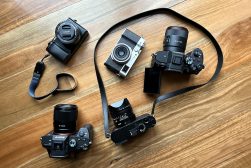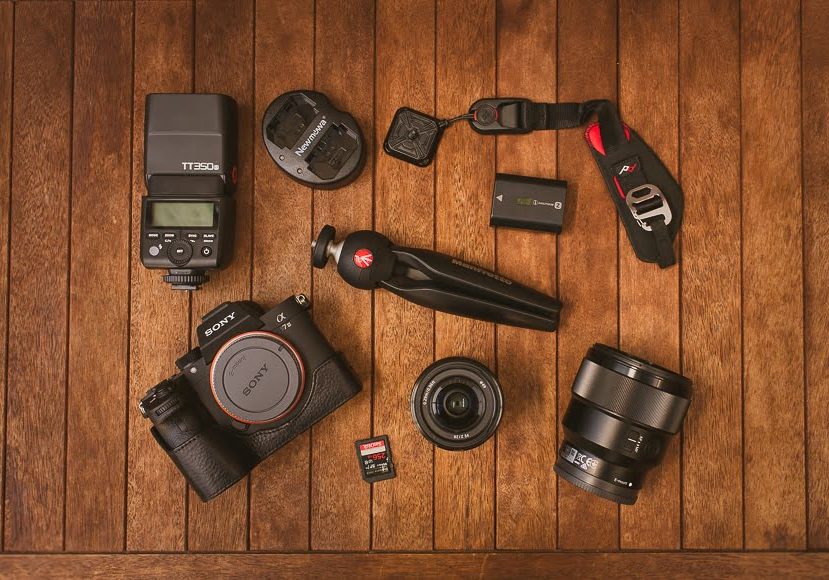
Best Sony Camera Accessories
If you own a Sony e mount or FE mount camera, don’t miss this guide to the best Sony accessories in 2024. Includes budget options too!
After shooting with Sony cameras for several years both professionally and for pleasure, I thought it was about time I put together a post on the best Sony camera accessories for photographers.
Sony mirrorless cameras and lenses have had a huge surge in popularity of late, with Sony winning numerous awards for its technological advancements.
There are now so many great accessories available in 2024, it may be hard to choose among them.
Below we’ve listed our favorite gizmos and gadgets you can use with your E-mount or FE-mount Sony camera to make it work just that little bit better.
(Unless otherwise stated, all the products listed below work on all the different cameras in the Sony Alpha range.
Best Sony Camera Accessories in 2024
| Image | Product | Details | |
|---|---|---|---|
 | Jackery Bolt 6000Best power pack |
| View Price → |
 | Newmowa Dual USB ChargerBest battery charger |
| View Price → |
 | Gariz Leather Half-CaseBest case |
| View Price → |
 | Peak Design 5L SlingBest bag |
| View Price → |
 | Peak Design ClutchBest hand strap |
| View Price → |
 | Sony 24mm f/1.8Best Sony e-mount lens |
| View Price → |
 | Sony 35mm f/1.4Best Sony FE-mount lens |
| View Price → |
 | Godox TT350SBest flash |
| View Price → |
 | Godox X1T-S TTL Best wireless transmitter |
| View Price → |
 | GorillaPod HybridBest tripod |
| View Price → |
 | SanDisk Extreme U3Best memory card for e-mount |
| View Price → |
 | Sony SF-G UHS-IIBest memory card for FE-mount |
| View Price → |
 | Expert Shield CrystalBest screen protector |
| View Price → |
 | Rode VideoMicroBest shotgun mic |
| View Price → |
 | Zhiyun Crane 2Best gimbal |
| View Price → |
 | Feelworld FW-760Best monitor |
| View Price → |
I’ve focused on the best accessories for Sony Alpha Interchangeable-Lens Cameras in general, but you can also see the best Sony a6000 accessories for more specific recommendations for that camera.
Recommended Batteries & Chargers for Sony Cameras

Sony accessories – batteries and chargers
One helpful feature of Sony cameras is being able to charge them via micro-USB. That means you can always take extra juice with you via a portable power pack.
My favorite is the Jackery Bolt 6000. Many people already use it for their iPhones but it works great for Sony cameras as well.
It charges amazingly quickly doesn’t weigh much, making it easy to carry with you. It comes with a built-in micro-USB cord and lightning cable so you won’t ever have to worry about forgetting any cables.
If you need more charging capacity than the Jackery Bolt 6000 has to offer, the Anker PowerCore 20100 is another great option. It has almost twice as much charging capacity as the Jackery Bolt 6000, though you’ll have to remember to bring cables along with you.
Most Sony cameras come with a dedicated battery charger, but the Sony a7 III does not. If you get annoyed with the rather fiddly micro-USB cable, I highly recommend the Newmowa Dual USB Charger (pictured above) for Sony Alpha mirrorless cameras. One of the most nifty Sony A7iii accessories to have.
At less than 15 bucks, it’s the most affordable and efficient way to charge two batteries at the same time for cameras like the Sony a7 III. Two LED lights tell you when each battery is charged to full capacity, and the whole thing weighs next to nothing, so is easy to pack for travel.
If you need a battery charger with circuit protection, the more expensive RAVPower NP-FW50 is your best bet.
One great benefit to the fact that Sony’s batteries charge via USB is that you can plug your camera in to a power pack for a completely portable set up.
As for the batteries themselves, while there are numerous third party options available, I always recommend buying Sony branded batteries, to maximise both the longevity of your battery charge and the life of your camera.
The excellent Sony Z-series batteries allow me to get over 800 shots out of a single charge on my Sony a7 III – a figure that’s fast approaching DSLR battery life.
If you’re into time-lapse photography and need a way to ‘hot-swap’ external battery packs mid-shot, you’ll need the Tether Tools Case Relay Camera Power System – if you already have a couple of portable battery packs or want to use wall power, you can save a little money by buying the Case Relay System separately.
For flashes and other gadgets that take double-AA batteries, I now don’t go anywhere without my Eneloop batteries. They’re simply amazing in that they can literally hold a charge for years. I keep Eneloops inside my backup flash, and don’t need to worry about them still having any remaining charge if I ever come to use them.
Recommended Camera Grips, Cases & Straps for Sony Cameras
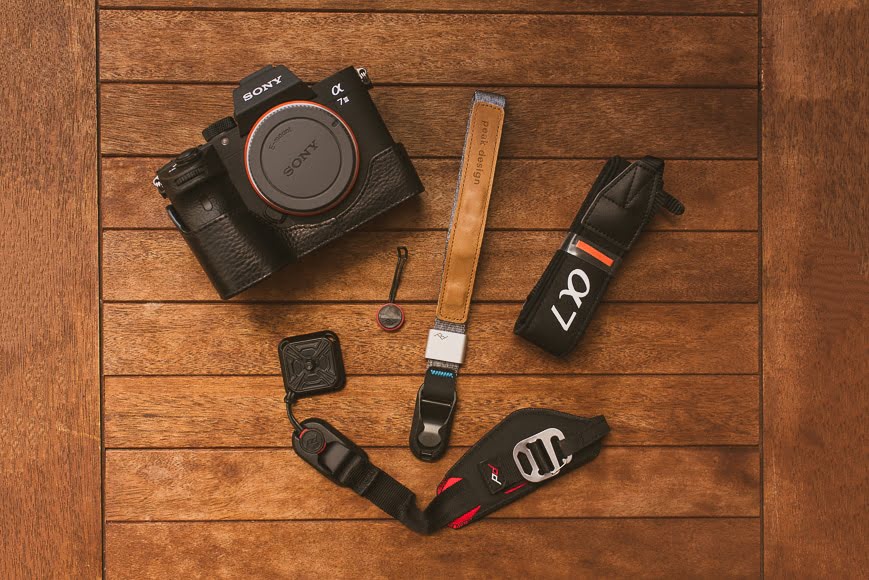
Sony accessories – grips, cases & straps
My main gripe when switching from a Nikon DSLR to Sony mirrorless cameras (Sony a7R III & Sony a7 III was the significant downgrade in ergonomics.
The Sony a7 III may be the most technologically advanced full frame camera on the market, but it still feels pretty awful to hold!
I’m not a fan of the slippery metallic body and sharp edges of Sony cameras, so the first Sony accessories I buy are things to improve how they feel in my hands.
Grips are must-have Sony Alpha accessories to improve ergonomics.
I actually bought 2 grips to trial on my a7 III – the Sony Vertical Grip and the Sony Grip Extension.
The Sony Vertical Grip allows you to double the battery life of Sony FE-mount (full frame) cameras, and also offers useful portrait orientation buttons/dials.
The Sony Grip Extension is a simple (albeit overpriced!) way to increase the grippable area of the camera body, giving a little extra space on which to rest your lower two fingers. It’s decent but uses the screw socket at the base of the camera, so needs to be removed when using a tripod or some camera straps.
I ended up selling the Sony Vertical Grip since it made my camera too bulky for my bag (and I was too lazy to remove it each time!)
Incidentally, a far more affordable alternative vertical grip is the Powerextra VG-C1EM, which gets great reviews and is currently 1/4 the price of the Sony branded model.
I’m also currently experimenting with a Gariz Leather Half-Case, and must say I’m impressed with its design and the way it gives my a7 III a little extra grip on the lower-half of the body. It also makes the camera more comfortable to use for longer periods.
I usually go strap-less with my camera bodies while doing professional work, but choose to attach one while traveling or for personal stuff. I own several camera straps, but I’m currently experimenting with the Peak Design Cuff with my Sony a7 III.
Aside from being very-well designed products (typical of Peak Design), I love the ability to quickly remove their straps from the camera body using innovative ‘Anchors’.
If you need a way to attach your Sony camera to your backpack or messenger bag strap, the Peak Design Capture Clip is a great product too.
Rotating between hand straps, the half-case and the occasional camera shoulder strap makes camera use more interesting and fun for me.
In addition, using traditional leather camera straps and grips helps to give a bit more ‘soul’ to the distinctly computer-like feel of the Sony mirrorless cameras. I’m looking forward to getting my hands on the MoneyMaker Solo for review soon.
Recommended Camera Bags for Sony Cameras

Sony accessories – camera bags
No Sony camera accessories list would be complete without a section on camera bags.
I’ve already written generic posts on the best camera bags, camera backpacks, womens camera bags and camera sling bags, so will include some of my current favourites specific to smaller camera gear set ups below.
If you’re like me and started out with a DSLR, you’ve probably significantly down-sized the camera gear you carry around with you by now. (See how I shoot weddings minimally here.)
Hauling around less camera gear can be quite refreshing. It also allows you to take advantage of the smaller, more ergonomic camera bags too.
Although I admit to still using my beloved Think Tank Airport Advantage (the lightest rolling camera bag), I also own numerous other smaller camera bags, which I rotate depending on the shoot.
My current favourites are the Peak Design Everyday Sling (in both 5L and 10L variants, reviewed here), the Think Tank Turnstyle 20 (reviewed here) and the Billingham Hadley Pro.
When traveling, I use an F-Stop Medium ICU in conjunction with whatever regular travel bag I’ve packed.
For smaller items like memory cards, batteries, and cables, I use the Peak Design Field Pouch. It’s slim-line design and numerous pockets really help me stay organized.
There aren’t really any camera bags made specifically for Sony cameras, but you really don’t need them. Anything designed to help you pack less is a good thing. That’s one of the beauties of going mirrorless.
Recommended Lenses for Sony Cameras

Sony accessories – Lenses
I’ve written about the best Sony lenses and the best Sony a6000 lenses previously, so click on those links if you want some more information and example photos.
Whether you use a DSLR or a mirrorless camera, every camera user should own a prime lens.
Of course, zoom lenses are quite practical and I would certainly encourage their use in the right situations. That being said, the smaller, lighter prime lenses really allow you to take advantage of the reduced size of Sony mirrorless camera bodies.
Now, that’s not to say that all Sony prime lenses are small and light! I use a Sony 35mm f/1.4 Zeiss lens for my wedding photography work, and it’s a bit of a beast…
However, compared to something like the Sony 24-70mm f/2.8 G Master zoom, it’s still petite ;-)
On the topic of which Sony lens to buy first, well in my opinion everything should start at the classic focal length of 35mm – many a career has been built off a 35mm lens, including my own.
If you own a Sony E-mount body like the Sony a6000, a6300, a6500 etc., I recommend you invest in the excellent Sony 24mm f/1.8 Sonnar T* ZA lens.
[Related: review of the Sony a6500 and best a6500 lens]
This will give you that coveted 35mm field of view, and the f/1.8 aperture will allow you to shoot in lower light without unnecessarily raising your ISO, and allow you to blur the out of focus areas (‘bokeh’) beautifully.
On a Sony FE-mount body like the Sony a9 and a7 series, I can whole-heartedly recommend the incredible Sony 35mm f/1.4 Zeiss. I shot with the Nikon equivalent for several years and loved that lens, but I have to say the Sony is actually sharper.
If you need something smaller as a walk-around lens, and don’t mind cranking up the ISO on your camera in low light, the Sony 35mm f/2.8 Zeiss is another excellent option.
At only 119g (4.23oz), it’s the perfect complement to the compact Sony bodies, and makes your whole set-up feel like a point and shoot camera! I know several photographers using the Sony 35mm f/2.8 Zeiss for pro work, and they swear by it.
Another prime lens focal length I recommend is 50mm. The nifty-fifty can produce a flattering portrait, and the narrower field of view and increased ability to blur the background (when compared to 35mm) can help isolate your subject.
Sony crop sensor owners can take advantage of the affordable, lightweight and optically impressive Sony 35mm f/1.8 lens, which translates to approximately 50mm in full frame terms.
For Sony full frame cameras, there’s the Sony 50mm f/1.8 at the affordable end, and at twice the price, the Sony 55mm f/1.8 Zeiss. Are those extra dollars worth it? Definitely. The 55mm is an incredible lens – probably the sharpest in the Sony line up, and optically superb.
As an added benefit of using a Sony full frame mirrorless camera, you have one click access to an APS-C crop mode. This means that if I’m using a 55mm lens, in one button press I can convert it to an 82.5mm lens. This is super useful when shooting a one-lens set up, which is what I aim to do as often as possible.
In February 2018, Sigma announced 9 brand new native Sony E-Mount Art series lenses, meaning Sony shooters can now take advantage of Sony’s high speed continuous AF (AF-C) and Eye AF with these third-party options.
Pricing for the Sigma Sony E Mount lenses is similar to their Nikon, Canon and Sigma mount counterparts, but still remains competitive when compared to Sony own-brand lenses.
I haven’t had a chance to properly test out these new lenses, but if Sigma’s previous ART lenses are anything to go by, they’ll be on par, if not better, than their Sony equivalents.
Recommended Flashes & Triggers for Sony Cameras
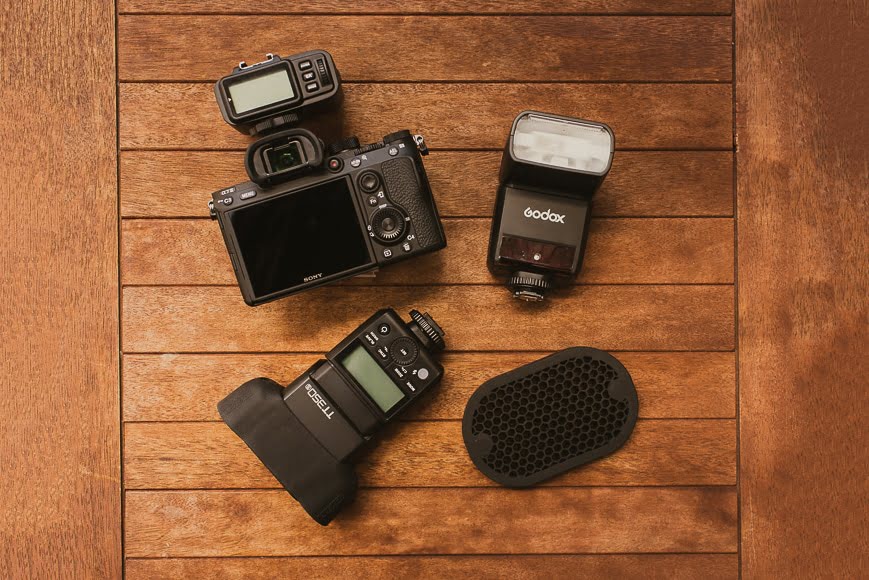
Sony accessories – flashes & triggers
There are several flashes available for the Sony mirrorless camera system, both Sony-branded and third-party.
If you’re a heavy flash user and rely on them professionally to be built to last, and fire and recycle as quickly as possible, the Sony-branded flashes such as the powerful and reliable Sony HVLF60M are the best option.
However, if you’re like me and only use flash as a last resort, (usually on the dance-floor at a wedding), you can save a lot of money by investing in the growing number of third-party options out there.
Godox flashes (sometimes known as Flashpoint, Cheetah, etc.) are an excellent option and work great on both crop sensor and full frame Sony cameras. Some might even consider them one of the best camera accessories for Sony.
I’m a recent convert to the Godox TT350s, a tiny, reliable and cheap flash option for my Sony a7 III.
The Godox TT350s has high-speed-sync, TTL, and surprisingly even has a receiver built-in! Considering their less than $90 price point, and how light they are (a measly 200g/7oz without batteries), you can’t go wrong carrying around a couple of these around.
If you’re looking for a flash trigger to go with them, the Godox X1T-S ITTL – is my choice. It’s reliable, lightweight, and simple to operate. It doesn’t hurt that it’s cheap as well.
I’m continually amazed at the fact that I can pack 2 flashes and 1 wireless trigger in the same amount of space as one of my old Nikon camera bodies!
If you’re an off-camera flash that has more power than the Godox TT350s, the Godox AD200 is a great choice. You can check out the full review here.
For on-camera flash use, the Godox V860II is a popular choice.It’ll give you up to 650 pops at full power and has a speedy 1.5s recycle time. You can get it bundled with the same X1t-S wireless transceiver and some other gizmos.
For those transitioning to Sony from other systems, you can you those flashes on Sony camera bodies as well – if you’re okay with sticking to manual mode.
In the world of flash modifiers, the MagMod system definitely worth a look. I’ve invested in just about every modifier they’ve put out, but these days tend to stick with the MagSphere and MagGrid when shooting wedding receptions. (You can get them both in the MagMod Starter Flash Kit).
If you take a look at the photo above you’ll see how the MagMod MagGrip fits easily around my Godox TT350s.
Occasionally I’ll also play around with the Manfrotto Lumimuse 8 LED light on my Sony cameras. I love how tiny it is, while offering a surprisingly powerful beam from the hot shoe. It can also be easily handed off to an assistant for use right out of their hand. (This is especially nice for setting up a quick, off-camera rim-light.)
Recommended Tripods for Sony Cameras
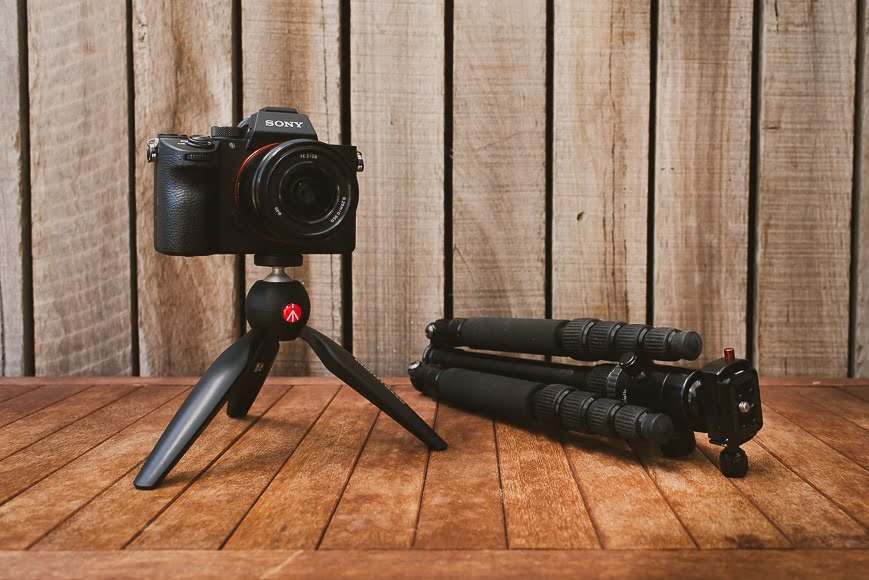
Sony accessories – tripods
I’ve written extensively on the best tripods in the past, so won’t go into too much detail here. Obviously, just about any camera can be used with just about any tripod camera, so recommending tripods for Sony cameras seems a little unnecessary.
Still, I do prefer certain tripods for use with my Sony a7 III – particularly those that help me really take advantage of its smaller footprint.
In the world of mini-tripods, you can’t really do better than the Gorillpod. Sure, there are a lot of cheaper knock-offs, but the real thing is still far superior. My favorite is the GorillaPod Hybrid.
I tend to use it the most when I’m filming. It helps me keep the camera at arm’s length (a la Casey Neistat!). I also own and recommend the Manfrotto B-PIXI mini-tripod for traveling and as a tripod for iPhones too.
While the GorillaPod is great in most situations, using it on the ground can be quite annoying. It’s can be a pain getting the legs exactly straight. That’s when I take out me B-PIXI. It’s simple and quick. You can also get it here with a neat mobile phone attachment, for filming B-Roll or taking a quick timed-selfie :-)
As for taller DSLR tripods, there are many great ones available, but I recommend the Rangers 57″ Lightweight Tripod. This little beast costs less than $70, can be used as a monopod, and most importantly, packs up small. Although you’ve probably never heard of Ranger tripods, they come with plenty of 5-star reviews.
As for triggering the Sony camera when attached to a tripod, the CamKix Wireless Bluetooth remote is quite handy. With it you can avoid camera shake from touching the shutter button when doing long exposure photography or HDR. It’s also useful for getting selfies without going through the Play Memories app.
Recommended Memory Cards for Sony Cameras
Obviously, you’re going to need to purchase some memory cards to go with your Sony camera. Some work better than others on Sony cameras, so it’s important to pay attention to which you get.
There’s also the question of recording video to memory cards. In order to be able to record in the high-bitrate that XAVC S uses, you’ll need a Class 6, 10 (or higher) card which is at least 64GB in size.
Space-wise, it’s best to buy the memory card with the biggest capacity you can afford, since running out of space while shooting sucks. In addition (and most people don’t think about this), every time you take a memory card in and out of your camera you increase the likelihood it will get corrupted. You also increase the chance that dirt or dust will enter the camera. The larger the capacity of your SD cards, the less you’ll be switching it out.
I recommend the SanDisk Extreme U3 UHS-I memory card for the Sony a6500 and other crop sensor Sony cameras.
With the money you save by getting a SanDisk ‘Extreme’ card (rather than the Plus or Pro versions which aren’t really necessary at this level), I recommend you get the largest capacity 256GB card, to ensure you never run out of space when filming at 4k.
If you own the Sony a9 or Sony a7 series of camera, a fast USS-II memory card is highly recommended especially if you shoot 4k.
As for stills photography, the faster write speed of the UHS-II format allows the camera to clear its buffer faster between burst shots. The faster read speed also makes the file transfer process quicker when you’re back at your computer.
Again, if you plan to shoot video, stick with SD cards that are over 64GB in capacity.
It’s worth noting that the 2nd SD memory card slot in your Sony camera doesn’t exploit the UHS-II speeds, and when you’re shooting to both slots simultaneously (for photo backup), the slower card will always be the bottleneck (i.e. the camera’s write speeds will be as fast as the slowest card in either slot when writing to both at the same time).
I have to admit I haven’t done any testing myself to ascertain which memory card combination works best, but there’s a useful real-world discussion here – prepare to be put to sleep with lots of data!
Either way, you should make sure to get the best UHS-II memory card for the primary slot if you want fastest performance, especially if you own the Sony a7R III (reviewed here) with its huge image files.
If you’re ready to invest in the absolute best memory card for your Sony full frame camera, the Sony SF-G UHS-II SDXC memory cards are the cream of the crop – you get the world’s fastest SD card performance – read speeds of up to 300 MB/s and write speeds of up to 299 MB/s.
Personally, I prefer having a larger capacity card than the absolute fastest write rates, so I use two 256GB SanDisk Extreme Pro memory cards which are cost-effective and very reliable.
Another good option is the Lexar Professional 256GB memory cards, despite Lexar as a company not existing any more.
Recommended Screen Protectors for Sony Cameras
For many of us, the first thing we do when we buy a smartphone is a get a screen protector. Well, the same should be true of anything with an LCD screen including getting one for your camera. (Touch screens even more so.)
For Sony Alpha camera screen protectors, I’d go with the Expert Shield Crystal Clear. You have to be careful when putting them on, but they lie flat and offer both good touchscreen performance and excellent good clarity.
Recommended Video Gear for Sony Cameras
I just started shooting video with my Sony a7 III.
Us stills-photographers rarely touch that little red ‘record’ button on our cameras, but I think it’s time we all started experimenting a bit :-)
Being able to shoot in 4k in conjunction with fast prime lenses can give cinematic video quality, and features like in-camera image stabilisation and full AF with subject tracking really makes capturing memories in motion-picture much easier than before.
I’m definitely no video expert, but I have a few friends who are, and they all shoot with Sony. The Sony accessories they recommended to a first time videographer like me are as follows:
Recommended Mic
If you’re just starting out with video, you may not yet have invested in an external mic, but they really do make all the difference.
For beginners, I’d go with the Rode VideoMicro. It’s affordable, works on-camera, and provides a great in-road for those wanting to capture high-quality audio off their Sony camera.
For an even less expensive on-camera shotgun mic, check out the Takstar SGC-598. Its audio quality and performance is often compared to the wildly popular Rode VideoMic Pro+, but the Takstar SGC-598 retails for only a fraction of the price of the Rode VideoMic Pro+.
I don’t have either one of these so can’t really testify to their quality. But if it were me, I’d try out the Takstar first. It’s so cheap you can’t really go wrong, especially if you need it only for occasional use.
Recommended Gimbal
If you’re really going to using your Sony camera for a lot of videos, you’ll want to invest in a gimbal. The smooth, cinematic shots you can get with one are a world apart from shooting without one. They also make it easier to hold your camera away from your body.
A quick internet search will bring up a lot of cheaper gimbals – and you might find the price tags tempting – but I wouldn’t go with them. In the world of gimbals you really do get what you pay for.
That being said, if you’re a beginner you also don’t need to break the bank. For Sony cameras, I’d start out with something like the Zhiyun Crane 2.
It won’t let you use the dial on the handle for focus-adjustment(a feature exclusive to Canon cameras), but luckily Sony’s subject tracking is quite excellent. Of course, you can also go old school and rely on your own manual focusing abilities.
If the ability to follow-focus using the gimbal’s dial is important to you, the Follow Focus device works well with the Zhiyun Crane 2.
Recommended Field Monitor
You may not yet have thought of getting a dedicated field monitor, but they really do make video life a lot easier.
A larger monitor atop your camera not only makes composing your shots worlds easier, it also makes checking the focus a relative breeze (especially when compared to doing it on your camera’s LCD screen).
There’s currently no Sony mirrorless camera that has a 180 degree rotatable LCD screen, so a hot-shoe mounted monitor is a must-have if you plan to use your Sony camera for vlogging.
The Feelworld FW-760 is a popular 7″ monitor option for Sony cameras – lightweight, high contrast, full HD and affordable. The IPS panel features a 160° degree viewing angle, and the unit feels secure when attached to your camera’s hot shoe.
For a cheap, DIY work-around to buying a dedicated field monitor, you can always try ‘streaming’ the Live View video from your camera to a smartphone via the Play Memories app. From there, attach your phone to your camera’s hot-shoe with a cheap CamKix adapter kit.
Final Words
There’s a reason Sony mirrorless cameras are some of the most popular on the market. Their class-leading performance, competitive pricing, and small profile make them a joy to work with.
Now, with the growing number of excellent Sony accessories available in 2024, it’s easier than ever to maximize the latest technology and smaller form factor these fantastic cameras bring to bear.
Stay tuned, as I’ll be adding to this list as more excellent accessories for Sony cameras come out.
Know of any Sony camera accessories you think should be on this list? Let us know in the comments below.










